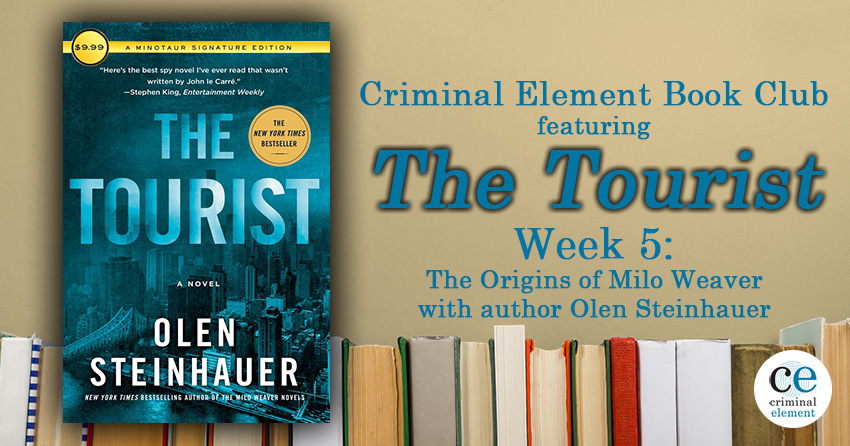Criminal Element Book Club, Week 5: Olen Steinhauer on the Origins of Milo Weaver
By Olen Steinhauer
February 3, 2020
When I first began writing about Milo Weaver in 2007, I was attempting to change course creatively. My earlier writing—five novels set in Eastern Europe during the Cold War—had begun to feel like a kind of escape from the messy, post-9/11 world unfolding around me. Instead of dealing with the world I was living in, I feared, I was leaning into the 20/20 hindsight of history in order to avoid the confusion of the contemporary world. I worried I was taking the easy way out. Thus, Milo Weaver, reluctant CIA officer in the Department of Tourism, was born.
I suspect this kind of shift is common for writers who have a few books under their belt. We look back on our work, notice its limitations, and feel a natural impulse to go beyond, to go further. Sometimes these shifts are tectonic, though more often they’re incremental, the shifts more apparent to the writer than to the casual reader, and some shifts are more successful than others. Happily, Milo’s initial trilogy, beginning with The Tourist and ending with An American Spy, worked out pretty well.
Though I’d never had plans to retire Milo completely, by the end of the trilogy that urge to shift gears nibbled at me again. Repetition is anathema to most writers, and I didn’t think I had a new story for Milo that would be fresh enough to justify a year of work. So I changed locales and characters with The Cairo Affair, then switched gears again with the slim All the Old Knives. I was enjoying these standalones, coming up with new ensembles and stories each year or so. To my mind, I was continuing that trend with The Middleman, a sprawling novel about political anxiety set (unlike my other novels) almost entirely within the United States.
I’ve written elsewhere about how The Middleman came from my own political anxieties, feelings that grew more acute with the approach of the 2016 election. It wasn’t just the state of American politics that brought it on; it was also the maturation of our daughter, who, at twelve, is more politically and socially aware than I was as a high school senior. Inevitably, I thought of how she, once she became interested, would look back on my life’s work.
So again I looked back on my earlier books, and asked if they examined the contemporary world as I experienced it now. In some ways yes, but in other ways no. Milo’s Tourism stories are very much inside baseball, spy-versus-spy, tempests in teacups that the rest of the world seldom see. What I wanted was to write about the current pulse of my own country, which is how I ended up with The Middleman.
The surprise, though, was that three-fourths of the way through writing it, I brought in one Milo Weaver for a cameo on which much of the plot hinges. I hadn’t planned that, but when it happened it helped bring together many strands, answer many questions, and created an unexpected bridge to a fictional universe I hadn’t visited in years.
But it did more than that. By bridging those two worlds plot-wise, the political sensibility of The Middleman crossed into Milo’s world, opening up the possibility of telling a more politically engaged Milo Weaver. That is, for the first time I was able to take an older creation, one already set in stone, and bring it into my contemporary understanding of what kind of writer I should endeavor to be. I could bring my old friend Milo along with me for the ride.
This shift in Milo’s world may not be immediately apparent to readers of The Last Tourist, but it’s there. While Milo continues to work in the shadow world of global espionage, his adversaries have grown beyond that world to take in the levers of global power, whose powers we interact with every day, quite often through the phones in our pockets.
So while The Last Tourist represents another shift in gears for me, it’s also a testament to the continuity and flexibility of a world I dreamed up in 2007 as my wife and I awaited the birth of our daughter, and how that child would influence the shape of something dreamed up when she—or at least the person she would become—was still just a figment of our imaginations.
Check back in next week for more exclusive content from Olen Steinhauer on his Milo Weaver series!
More: Listen to an audiobook excerpt of The Last Tourist by Olen Steinhauer:
About The Last Tourist by Olen Steinhauer:
In Olen Steinhauer’s bestseller An American Spy, reluctant CIA agent Milo Weaver thought he had finally put “Tourists”―CIA-trained assassins―to bed.
A decade later, Milo is hiding out in Western Sahara when a young CIA analyst arrives to question him about a series of suspicious deaths and terrorist chatter linked to him.
Their conversation is soon interrupted by a new breed of Tourists intent on killing them both, forcing them to run.
As he tells his story, Milo is joined by colleagues and enemies from his long history in the world of intelligence, and the young analyst wonders what to believe. He wonders, too, if he’ll survive this encounter.
After three standalone novels, Olen Steinhauer returns to the series that made him a New York Times bestseller.

